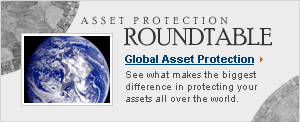Kinetic Asset Protection – The foundation of strength!
An asset protection plan is not just a pile of expensive files to document what you own and control. The reality is that a properly conceived kinetic asset protection plan is more closely analogous to that of a living organism that changes and evolves over time. This plan and its workings are the traceable flow of property, capital and assets through a person's estate or wealth in relationship to the exposure of liability. A plan, like a person, has different stages of life.
The initial focus is on the capitalization, or the funding.
An Asset Protection Plan (Kinetic or Otherwise) should only be set up (e.g. funded) when the financial seas are calm. If there is a fraudulent conveyance, it takes place on the day the plan is funded. That is also the date that the statute of limitations begins to run.
Procuring a plan requires great care to make sure that the act of funding the trust is not a fraudulent conveyance. Does this mean that you cannot initiate asset protection if you have problems such as a pending lawsuit or demand letters? The answer is usually that you can still protect yourself provided you retain plenty of assets in an unprotected environment to satisfy any potential judgment from the known claim.
Generally, when a threat letter appears on the desk of the client's attorney there is an emerging scenario of danger. Often this is a wake up call regarding the liability of a client's assets. The first determination is the threat of a creditor seizing cash via bank accounts and insurance policies. For a creditor�s attorney this is a simple process and an easy take. For the client this realization is devastating, but keep in mind that it requires a judgment to take anything. Keep in mind that the danger begins when the plaintiff's attorney writes a �demand� letter, which is generally the first step toward resolution of a dispute.
At this point, there must be three or four times the worst-case scenario in unprotected assets at the time the plan is funded once a threat is in place. This of course is another point in favor of implementing an asset protection plan when the financial seas are calm.
Take this true case of a surgeon, a young and happy bachelor with a great income, who was sued by a girl he had dated once or twice. She claimed he had kissed her and given her a cold sore on her mouth. She demanded $500,000. This wake up call scared the Doctor. He consulted with his attorney, who diagnosed this as a typical contingent fee lawyer shake down suit with a worse case exposure of less than $50,000. The Doctor happened to own a corner lot (former gas station and not one of his prime assets) with just about $100,000 of equity in it. We left that unprotected and proceeded to protect the rest of his assets. The claim by the former girlfriend was just a wake up call.
Provided the plan is funded when the financial seas are calm it is completely appropriate to have the client who is usually the Settlor also be the U.S. Trustee and sometimes the Protector. It is always wise, when the financial seas are calm, for the client to retain the power to invest and otherwise deal with the protected assets. The client will keep this control by virtue of his status or position of being the U.S. Trustee. A typical Kinetic Asset Protection Trust will have the U.S. Trustee having the power to invest the assets alone, without the involvement of the Foreign Trust Company, during all periods when there is no attack on the trust (also known as an �Event of Duress�).
When the financial seas are calm, the assets are often in the USA and often held by an entity known as a Family Limited Partnership. Note, this is just the same as any limited partnership except that practitioners found out that they could charge more if they added the word �family� to the title. We will talk in detail about FLP's at trustmakers.com . An FLP integrated with a Kinetic Asset Protection Trust normally has the trust as the limited partner. The trust has no control and a majority of the ownership over protected assets (normally 99%).
MOVING TO RED ALERT
The first step to move toward more solid protection (something we refer to as �Red Alert Status�) is for the Settlor to appoint a foreign person as Protector. This person is often a lawyer or solicitor in a jurisdiction other than the USA . This Protector will also often go onto the accounts with the U.S. Trustee (aka client). Some clients start out with a foreign person as the Protector, particularly if they are in a high-risk environment.
This is just a small excerpt about the Kinetic Module of Asset Protection. If you have more interest or would like to implement a Kinectic Asset Protection Plan. Please sign up for a Consultation.
Learn about the Kinectic Module. Purchase our 10 Session Seminar.

WHAT IS A TRUST

EDUCATION PRODUCTS

Asset Protecion Training
If you are looking for the most important concepts in Asset Protection, this is where to start! If you need to talk intelligently about protecting your net worth or you are a professional this online training program is for you!

Free Asset Protecion Course
Get our Free Online Asset Protection Video Course.
Learn how to protect yourself like the pros!


Asset Protection in a Nutshell
Clear, concise and straight forward, this e-Book will help you make sound decisions with your business and personal assets..

Protecting Assets - 70+ Video Lessons + 3 Ebooks
This e-course will give you straight forward asset protection advice you can implement now. One of the best asset protection courses available! Includes 70+ video lessons, 3 Ebooks, and 6 example legal documents!

Advanced Estate Planner
The key to a solid Asset Protection Plan is the Estate Plan. This downloadable estate organizer will help you keep track of important information about your assets and important legal documents all in one place.
















